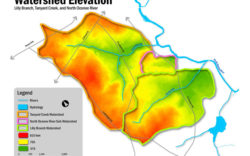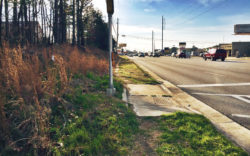The return of the school year brings with it a few weeks of transportational chaos as thousands of new residents appear in Athens, many of whom are learning how to navigate campus and town for the first time. Though everyone can use a refresher, it’s for that group that I present this guidance on how to get yourself around without a car.
But before my motorized readers skip this article, texting and driving is illegal in Georgia, and that includes doing it while your car is stopped in traffic. People in a crosswalk have the right of way, and if you’re turning at an intersection, you have to let them cross first. There is a 3-foot passing law in Georgia, which means that the driver of a motor vehicle must leave 3 feet of space between their vehicle and a person on a bicycle when passing. If you can’t safely pass with 3 feet of clearance, then, as Gandalf says, you shall not pass. There—glad we got that out of the way.
By Bus
According to 2014 data, Athens-Clarke County has the fourth busiest transit system per capita in the country, when looking at combined ridership between the UGA and Athens-Clarke County transit systems. Campus Transit handles the vast majority, with about 12 million rides per year.
Campus Transit buses are free for anyone to use, and they stop at every stop on the route. You can hop on and hop off at any stop. There’s more space out than in, so just remember to step back and let people get out of the bus first, and take your backpack off if it’s crowded.
Athens Transit buses are free for anyone with a valid UGA ID card, which riders swipe at the farebox when entering at the front of the bus. UGA Transportation and Parking Services uses the student transportation fee to pay the county a discounted fare per swipe. County buses do not automatically stop at every stop on the route, so you have to pull the stop request cord that runs along the windows.
The UGA Mobile App has extremely useful transit maps and bus trackers that work with both the Campus and ACC Transit systems. Use it to find stops near you, which routes go where, and how soon the next bus will arrive. Bus stops are also visible on Google Maps, thanks to a project by the 2015 LEAD Athens civic leadership class. Both systems have maps and bus tracking available on their respective web sites, as well: transit.uga.edu and athensclarkecounty.com/transit.
County buses have had bike racks on the front of them for years, but starting this semester UGA buses will have them too. This allows people with bikes to have much more flexible transportation options and cover a broader range. The bike racks are easy to use but may be intimidating the first time. Luckily, they are the same as the ones used by Transit Authority of River City (Louisville, KY), which produced an awesome video about them.
By Bike
A bike is by far the fastest way to get around campus. I once raced notable Athens music scenester and biological engineer Dan Geller on his scooter from the Driftmier Engineering Center to the Arch (the southern and northern extremes of campus). While I won’t say who won, I will say that I made it on my bike in 10 minutes without breaking any laws, and I didn’t have to pay for parking.
For those new to biking for transportation in an urban environment, it is important to know that bikes are considered legal street vehicles in Georgia and must be operated according to the same applicable rules of the road as a car. That means stopping at red lights and stop signs, yielding to pedestrians when they have the right of way and signaling turns. It is illegal to ride on the sidewalk in Athens, but there are wide multi-use paths throughout campus, as well as the Greenway, where bikes are allowed. Know that when you ride at night, you must have at least a white headlight and red rear reflector (though a red taillight is better), and it’s a $150 ticket if you’re caught without them.
Georgia Bikes is a great resource to learn more: See georgiabikes.org for bike laws and safe riding tips. You can also pick up a copy of their Bicyclist Pocket Guide from the UGA Office of Sustainability, or from BikeAthens at 1075 W. Broad St. BikeAthens also offers Traffic Skills 101 classes and other educational opportunities (see bikeathens.com/education).
A well maintained bike is a safe bike, and now that you’re away at school, you’re the one responsible for keeping your bike rideable. There are four FixIt stations with pumps on campus (you can find them in the UGA Mobile App) and one on College Avenue outside of the parking deck downtown. Keeping air in your tires is a fundamental way to keep your bike happy, but to do more, you can bring your bike to BikeAthens on Thursdays for Fix Your Own Bike nights to learn basic to advanced maintenance and repair skills (see bikeathens.com/fyob).
Students without bikes who want to take a ride can check out a Bulldog Bike from one of the UGA libraries. See sustainability.uga.edu/bulldogbikes to register. (Psst: While this program is only available to active students and employees, UGA is investigating options to make bike-sharing available at more campus locations and for any campus visitors.)
If you don’t remember anything else about riding a bike here, remember this: Be Visible, be predictable, and be courteous. For more information about biking at UGA, visit sustainability.uga.edu/bike, or email questions to [email protected].
On Foot
If you visit the UGA subreddit this time of year, there are a lot of people asking if they can walk from building A to building B within a 15-minute class change. The answer is usually yes, but thanks to the new centralized classroom scheduling that may put your biology class in the Fine Arts building, sometimes no. To give you a sense of scale, it takes this average adult about 35 minutes to walk the full north-south length of campus. Most people can walk a quarter-mile in five minutes, but be sure to account for time getting in and out of buildings when you decide on your own travel strategy.
If you have been here for orientation, then you probably experienced the “pedestrian scramble” at Baxter and Lumpkin, where the pedestrian crossing cycle allows people to walk in any direction while cars wait. This is a great solution for this busy intersection, but don’t assume that this is the norm: There are very few pedestrian-only cycles elsewhere on campus or in town. Also, some intersections in Athens have automatic pedestrian crossing signals, while others won’t activate unless you push the “beg button.” If you see a button, push it, or be left awkwardly waiting.
As the most vulnerable road users, people on foot paradoxically wield the most power, as they have the ultimate right of way at crosswalks. With great power comes great responsibility, so—I can’t believe I have to tell you this—look both ways before you step off the curb, and don’t assume bikes and cars will be able to stop in time for you. Crosswalks are not force fields, and unfortunately people do get hit in them here.
Finally, I don’t know how to say this without sounding like a grumpy old dude, so I’ll just say it: Put your damned phone away while you’re walking, especially when crossing the street. If you must look at your phone, take a step out of the way and do it. Everyone around you will appreciate it.
Watch for Dawgs Day
Sept. 8, Tate Plaza, 8:30 a.m.–2 p.m.
UGA Auxiliary Services is teaming with campus and community partners for a transportation safety event to launch the Watch for Dawgs campaign. It will feature hourly prize giveaways, safe cycling demonstrations, bike tune-ups, a Campus Transit bus with a bike rack to practice on, UGA’s Taqueria 1785 food truck and other activities.
Like what you just read? Support Flagpole by making a donation today. Every dollar you give helps fund our ongoing mission to provide Athens with quality, independent journalism.










